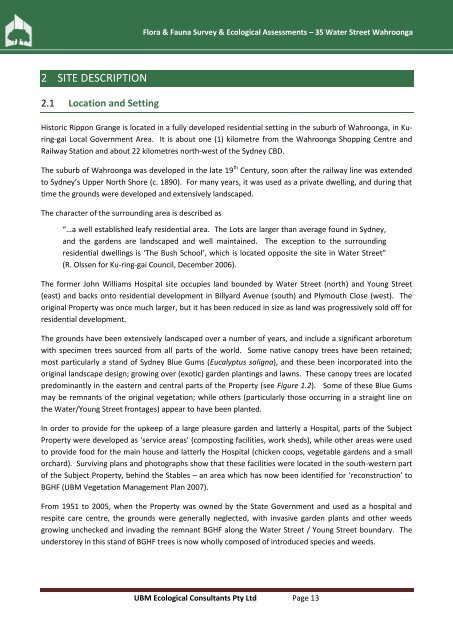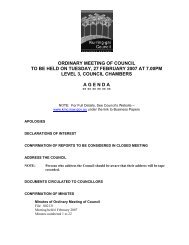Flora & Fauna Survey & Ecological Assessment (pdf. 5MB)
Flora & Fauna Survey & Ecological Assessment (pdf. 5MB)
Flora & Fauna Survey & Ecological Assessment (pdf. 5MB)
Create successful ePaper yourself
Turn your PDF publications into a flip-book with our unique Google optimized e-Paper software.
<strong>Flora</strong> & <strong>Fauna</strong> <strong>Survey</strong> & <strong>Ecological</strong> <strong>Assessment</strong>s – 35 Water Street Wahroonga<br />
2 SITE DESCRIPTION<br />
2.1 Location and Setting<br />
Historic Rippon Grange is located in a fully developed residential setting in the suburb of Wahroonga, in Kuring-gai<br />
Local Government Area. It is about one (1) kilometre from the Wahroonga Shopping Centre and<br />
Railway Station and about 22 kilometres north-west of the Sydney CBD.<br />
The suburb of Wahroonga was developed in the late 19 th Century, soon after the railway line was extended<br />
to Sydney’s Upper North Shore (c. 1890). For many years, it was used as a private dwelling, and during that<br />
time the grounds were developed and extensively landscaped.<br />
The character of the surrounding area is described as<br />
“…a well established leafy residential area. The Lots are larger than average found in Sydney,<br />
and the gardens are landscaped and well maintained. The exception to the surrounding<br />
residential dwellings is ‘The Bush School’, which is located opposite the site in Water Street”<br />
(R. Olssen for Ku-ring-gai Council, December 2006).<br />
The former John Williams Hospital site occupies land bounded by Water Street (north) and Young Street<br />
(east) and backs onto residential development in Billyard Avenue (south) and Plymouth Close (west). The<br />
original Property was once much larger, but it has been reduced in size as land was progressively sold off for<br />
residential development.<br />
The grounds have been extensively landscaped over a number of years, and include a significant arboretum<br />
with specimen trees sourced from all parts of the world. Some native canopy trees have been retained;<br />
most particularly a stand of Sydney Blue Gums (Eucalyptus saligna), and these been incorporated into the<br />
original landscape design; growing over (exotic) garden plantings and lawns. These canopy trees are located<br />
predominantly in the eastern and central parts of the Property (see Figure 1.2). Some of these Blue Gums<br />
may be remnants of the original vegetation; while others (particularly those occurring in a straight line on<br />
the Water/Young Street frontages) appear to have been planted.<br />
In order to provide for the upkeep of a large pleasure garden and latterly a Hospital, parts of the Subject<br />
Property were developed as ‘service areas’ (composting facilities, work sheds), while other areas were used<br />
to provide food for the main house and latterly the Hospital (chicken coops, vegetable gardens and a small<br />
orchard). Surviving plans and photographs show that these facilities were located in the south-western part<br />
of the Subject Property, behind the Stables – an area which has now been identified for ‘reconstruction’ to<br />
BGHF (UBM Vegetation Management Plan 2007).<br />
From 1951 to 2005, when the Property was owned by the State Government and used as a hospital and<br />
respite care centre, the grounds were generally neglected, with invasive garden plants and other weeds<br />
growing unchecked and invading the remnant BGHF along the Water Street / Young Street boundary. The<br />
understorey in this stand of BGHF trees is now wholly composed of introduced species and weeds.<br />
UBM <strong>Ecological</strong> Consultants Pty Ltd Page 13

















